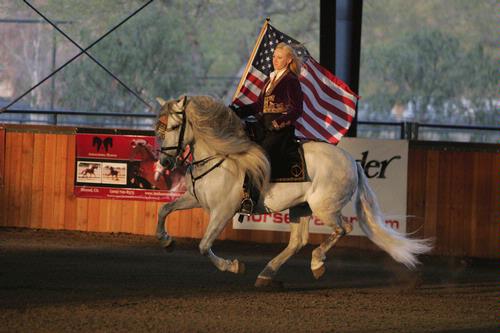The Pura Raza Española (P.R.E.) has been linked with the history and the culture of Andalusia since time immemorial. There are cave drawings dating back to 5,000 BC found in the caves of Altamira and Canforos de Penarubia in northeastern Spain depicting native horses whose body types are remarkably like today's horse. These drawings depict the predecessors of the Pure Spanish Horse. Originally used in warfare, as a means of transport and for other work, the industrial revolution changed his role to that of man's companion in sport and leisure activities, in which he is one of the leaders in the Andalusian region. The Pure Spanish Horse has been an integral part of Spain from its beginnings and contributes much to our better knowledge and understanding of its landscape, customs and people.
 The Pure Spanish Horse was unified as a breed in the sixteenth century (between 1567 and 1593) by the Spanish King Felipe II who formally established the standards for the breed which we recognize today as the Pure Spanish Horse. During these years King Felipe II decided to bring to life the universally idealized horse which has been so long pictured in history, in bronze, in paintings. He looked at the basic horse bred in Spain, selected the best of those examples which came closest to the idealized animal he desired, and directed that the idealized horse be produced. Concurrent with his breeding program, the humanistic approach was spreading through Spain and the teachings of the ancient Greek Xenophon were put into practice for the treatment and training of these carefully bred horses.
The Pure Spanish Horse was unified as a breed in the sixteenth century (between 1567 and 1593) by the Spanish King Felipe II who formally established the standards for the breed which we recognize today as the Pure Spanish Horse. During these years King Felipe II decided to bring to life the universally idealized horse which has been so long pictured in history, in bronze, in paintings. He looked at the basic horse bred in Spain, selected the best of those examples which came closest to the idealized animal he desired, and directed that the idealized horse be produced. Concurrent with his breeding program, the humanistic approach was spreading through Spain and the teachings of the ancient Greek Xenophon were put into practice for the treatment and training of these carefully bred horses.
While the historical use of the Pure Spanish Horse in Spain was first as a farm horse to work with the brave bulls destined for the bull rings, it was also the horse which carried its lords into battle and equally proudly carried them in their moments of triumph as a parade horse. The Pure Spanish Horse is still used in Spain to fight in the bull ring and still used to work stock on the farms, and of course, is considered one of the national treasures of Spain, an inheritance handed from father to son through generations. The horse is used in dressage competitions, in competitive driving as single horse or four-horse hitch, and in the discipline distinctly Spanish, the Doma Vaquera - formalized as the show ring version of farm work, most closely related to a reining pattern with combined dressage elements.
In the USA, we don't have bull fights, but the Pure Spanish Horse has been found to be adept at all the disciplines one would expect: dressage, hunt seat, saddle seat, western pleasure, parades, trail, and certain of our horses even excel as open jumpers. Their conformation hints at their capabilities: strong boned legs, good slope to the shoulder, deep heart-girth, round powerful haunches. The classically beautiful head of a Pure Spanish Horse is unique and an instant identifier of its breed. One can read the history in their large oval eyes inside a triangular-shaped orbital arch and can imagine strength for extended efforts in the inverted comma-shaped nostrils which expand downward to bring in large quantities of air. And of course there are the unique racial characteristics in the shape and dexterity of the upper lip, the sensitivity of the mouth and the point of the chin.
In Andalusia, where most of the Pure Spanish Horses are bred, the Pura Raza Española horse predominates. It is the heir of the Cartujano horse, which attracted the admiration of Kings and became the preferred mount of Royalty and the Cavalry. This horse made its second official appearance in the USA in the late 1960s (the first having been in the cargo holds of the voyages of the Conquistadores beginning with second voyage of Christopher Columbus). The process of importation was difficult and costly; the population grew slowly, having only recently reached the 5,000 mark of Pure Spanish Horses in the USA.
(Text from www.prehorse.org)